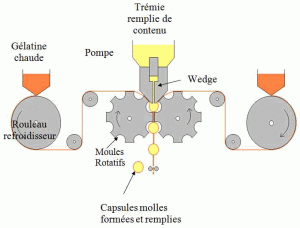Capsules Manufacturing Process :
- Fill preparation :
Equipment used :
– Stainless steel tanks of various capacities
– Weighing machines (with electronic recording) of various range
– Process mixer (with variable speed)
Fill preparation:
– Computer controlled weighing of raw materials
– Raw materials mixing (shaken) until mass homogeneity (grinding and sieving for pastes, emulsification for emulsions)
– Broyage et tamisage si nécessaire
– Under vacuum deaeration
– Storage in closed stainless steel tanks
- Gelatin preparation :
Equipment used :
– Weighing machines (with electronic recording) of various range
– 600 liters or 1000 liters blender
– Process mixer (with variable speed)
– Storing temperature controlled tanks of various capacities
– Stainless steel sieve from 250 μm to 600 μm
Préparation de la masse de gélatine :
– Weighing of gelatin mass: gelatin, glycerin, water, dyes
– Blending and heating of raw materials gelatin/water/glycerin until getting a homogeneous liquid blend
– Deaeration of gelatin mass
– Distribution in temperature controlled mobile tanks
– Adding of dyes and/or aromas and/or glitter by shaking until total homogeneity of gelatin mass
- Encapsulation :

– The gelatin solution is divided, in thin ribbon form of constant thickness, on two rotating cooled cylinders.
– When touching the cool cylinders, the gelatin ribbon solidifies and becomes a solid ribbon.
– Capsules are formed when the two jellified ribbons pass through two identical rotating molds, which have cells on their circumference determining capacity and size of capsules.
– A dosage pump injects the fill in each cell. The two gelatin ribbons take the cell shape under injected fill pressure.
– The so formed capsules are sealed by heat and pressure exerted by the molds.
– Capsules then go through rotating tumble dryers where they start losing their water.
- Drying:
– After the first drying in the tumble dryers, capsules are displayed on trays and trolleys.
– Full trolleys are then placed in drying corridors, in which there is a dry and cool airflow.
– Capsules go on drying during 3 to 10 days until they fulfill customer’s
requirements.
- Control and packaging:
– Dry capsules are then controlled.
– Released capsules are counted and packed in plastic bags, closed with an inviolability link and put in a carton.
– Cartons are identified with a label mentioning customer’s address, product
code and name, batch number and quantity of capsules per carton.
